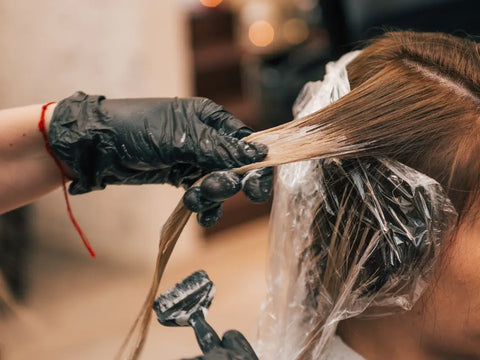Updating the color of a wig is a way to add your touch and give your appearance a new spin. Whether you want to coordinate your wig with your hair color experiment, with a daring style or just spruce up a favorite this manual will guide you through the steps to effectively dye a wig.
Understanding Different Types of Wigs
Prior, to beginning the dyeing procedure it is crucial to have a grasp of the kind of wig you are working with. This understanding will determine the methods for dyeing and the kinds of dye that're suitable, for use.
Human Hair vs. Synthetic Wigs

Human Hair Wigs are crafted from real, natural hair, making them versatile in terms of styling and dyeing. They can handle hair dye much like your own hair would, allowing for a more natural and long-lasting color. The key advantage of human hair wigs is their resilience and ability to withstand various chemical treatments.
Synthetic wigs on the contrary are crafted from man made fibers that imitate hair. Although advancements have been made in enhancing the quality and look of wigs they typically cannot be dyed using methods because of their plastic based composition. Nevertheless there exist dyes and methods to change the color of synthetic wigs a topic we will delve into further ahead.
The Best Wigs for Dyeing
For the most successful dye job, Virgin Human Hair Wigs are the gold standard. These wigs have not been processed or dyed, making them the perfect blank canvas for your color application.
Pre-Treated or Colored Wigs can also be dyed, but the results can be less predictable. It's important to consider how the new color will overlay with the existing shade and to adjust your expectations accordingly.
Preparing to Dye Your Wig

The key to a flawless dye job is in the preparation. Here's how to get your wig ready for a color transformation.
Choosing the Right Color
Selecting a color that not matches your style but also enhances your skin tone is key. Here are some pointers to help you pick the hue:
- For cool skin tones, look for shades with blue or purple undertones.
- For warm skin tones, opt for colors with a yellow, red, or orange base.
- Neutral skin tones can pull off a wide range of colors, so feel free to experiment.
Essential Tools and Materials
Before starting the dyeing process it's important to gather all the tools and materials. Here's a list of what you'll require:
- Hair dye: Choose a high-quality dye designed for the type of wig you're dyeing.
- Developer (if required): A developer activates the dye and helps it penetrate the hair shaft.
- Dye brush: This will help you apply the dye evenly.
- Gloves: Protect your hands from stains.
- Shampoo & Conditioner: Use products suitable for dyed hair to wash the wig before and after dyeing.
- Towel: Have a towel on hand to dry the wig after washing.
- Wig stand: This makes applying dye much easier.
Pre-Dye Wig Preparation
- Wash the Wig: Start with a clean base by washing the wig to remove any buildup.
- Detangle: Use a wide-tooth comb to gently detangle the wig, working from the ends up to avoid breakage.
- Dry the Wig: The wig should be completely dry before you start the dyeing process.
How to Dye Your Wig: Step-by-Step Guide
Dyeing Human Hair Wigs
- Mix the Dye: Follow the dye package instructions carefully to mix the dye with the developer.
- Apply the Dye: Section the wig and use the dye brush to apply the dye evenly, ensuring every strand is covered.
- Wait: Allow the dye to process for the recommended time.
- Rinse: Wash the wig until the water runs clear, then apply a hydrating conditioner.
- Dry: Let the wig air dry or use a blow dryer on a low heat setting.
Dyeing Synthetic Wigs (If Applicable)
Dyeing synthetic wigs requires specialized dyes that can adhere to the fibers. Fabric dyes or dyes specifically made for synthetic wigs are often used. Follow the specific dye instructions for the best results.
Aftercare: Maintaining Your Dyed Wig
To keep your newly dyed wig looking vibrant and healthy, follow these aftercare tips:
Washing and Conditioning
- Wash your dyed wig sparingly to prevent the color from fading. When you do wash it, use lukewarm water and gentle, sulfate-free products.
- Deep condition the wig regularly to keep the fibers soft and prevent dryness.
Styling Tips
- When styling your dyed wig, use heat protectant products and avoid high temperatures to preserve the color and integrity of the wig.
- Opt for silk or satin caps when sleeping to prevent friction and color fade.
Troubleshooting Common Dyeing Challenges
Here are solutions to some common issues you might encounter:
- Uneven Color: Reapply dye to lighter areas, following the same process as before.
- Dye Didn't Take: Virgin hair wigs are more receptive to dye. If your wig is synthetic or heavily treated, the dye may not take as expected. Consider professional dyeing services for challenging cases.
Inspiration: Creative Ideas for Wig Colors
Feel free to play around with colors. Whether it's pinks or rich blues choosing the perfect hue can really change up your style and boost your self assurance. Take cues from celebrities, fashion events and social media to get inspired.
Conclusion
Coloring a wig can completely transform your look. Breathe life into an old wig. By following these guidelines you can achieve salon quality outcomes in the comfort of your home. Keep in mind that the secret, to a wig coloring session is preparation selecting the appropriate dye and ensuring proper maintenance post dyeing.
